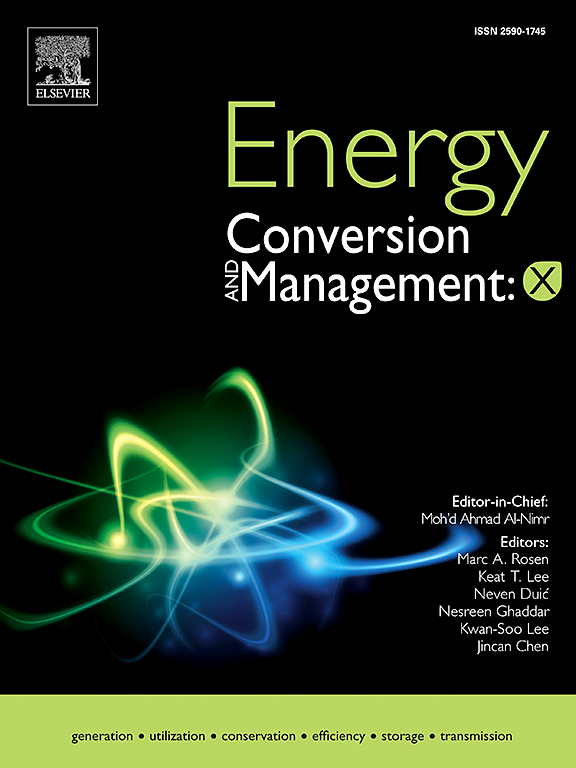在燃料电池模式全湿化条件下,利用交叉流场提高聚合物电解质膜单元化可逆燃料电池的性能
IF 10.9
1区 工程技术
Q1 ENERGY & FUELS
引用次数: 0
摘要
在聚合物电解质膜单元可逆燃料电池(pem - urfc)中,钛毡常被用作氧电极的气体扩散层(GDL)。虽然在电解模式下耐用,但在燃料电池模式下,它的水管理很差,导致水浸和性能下降。为了解决这个问题,引入了交叉流场,通过促进有效的脱水和反应物运输来提高燃料电池模式的性能。一项实验研究评估了交叉流场的pem - urfc与蛇纹流场的性能,通道深度分别为1.0 mm和0.6 mm,产生了四种不同的配置。在全加湿条件下,深度为0.6 mm的交错流场的峰值功率密度比深度为0.6 mm和1.0 mm的蛇形流场分别高42.7%和66.3%。当空气湿度降低(50%)时,深度为1.0 mm的蛇形流场的性能略高,但其优势很小(9.2%)。在电解模式下,即使在氢气压力升高的情况下,不同结构之间的电压变化也是最小的。总体而言,该研究实现了燃料电池的峰值功率密度为0.404 W/cm2,电池在0.4 a /cm2时的往返效率为44.2%,超过了之前报道的类似条件下的结果。这些发现强调了交叉流场在提高pem - urfc效率和性能方面的潜力。本文章由计算机程序翻译,如有差异,请以英文原文为准。
Performance improvement of polymer electrolyte membrane-unitized reversible fuel cells using interdigitated flow fields under a fuel cell mode fully humidified condition
In polymer electrolyte membrane-unitized reversible fuel cells (PEM-URFCs), titanium felt is often used as the gas diffusion layer (GDL) for the oxygen electrode. While durable in electrolysis mode, it suffers from poor water management in fuel cell mode, leading to flooding and reduced performance. To address this issue, interdigitated flow fields are introduced to improve fuel cell mode performance by facilitating effective water removal and reactant transport. An experimental investigation evaluates the performance of PEM-URFCs with interdigitated flow fields in comparison to serpentine flow fields, with channel depths of 1.0 mm and 0.6 mm, resulting in four distinct configurations. The interdigitated flow field of 0.6 mm depth achieves a peak power density 42.7 % and 66.3 % higher than the serpentine flow fields of 0.6 mm and 1.0 mm depths, respectively, under a fully humidified condition. Under reduced air humidity (50 %), the serpentine flow field of 1.0 mm depth achieves slightly higher performance, but its advantage is marginal (9.2 %). In electrolysis mode, voltage variations among the different configurations are minimal, even under elevated hydrogen pressures. Overall, the study achieves a fuel cell peak power density of 0.404 W/cm2 and a cell round-trip efficiency of 44.2 % at 0.4 A/cm2, exceeding previously reported results in similar conditions. These findings highlight the potential of interdigitated flow fields to enhance the efficiency and performance of PEM-URFCs.
求助全文
通过发布文献求助,成功后即可免费获取论文全文。
去求助
来源期刊

Energy Conversion and Management
工程技术-力学
CiteScore
19.00
自引率
11.50%
发文量
1304
审稿时长
17 days
期刊介绍:
The journal Energy Conversion and Management provides a forum for publishing original contributions and comprehensive technical review articles of interdisciplinary and original research on all important energy topics.
The topics considered include energy generation, utilization, conversion, storage, transmission, conservation, management and sustainability. These topics typically involve various types of energy such as mechanical, thermal, nuclear, chemical, electromagnetic, magnetic and electric. These energy types cover all known energy resources, including renewable resources (e.g., solar, bio, hydro, wind, geothermal and ocean energy), fossil fuels and nuclear resources.
 求助内容:
求助内容: 应助结果提醒方式:
应助结果提醒方式:


